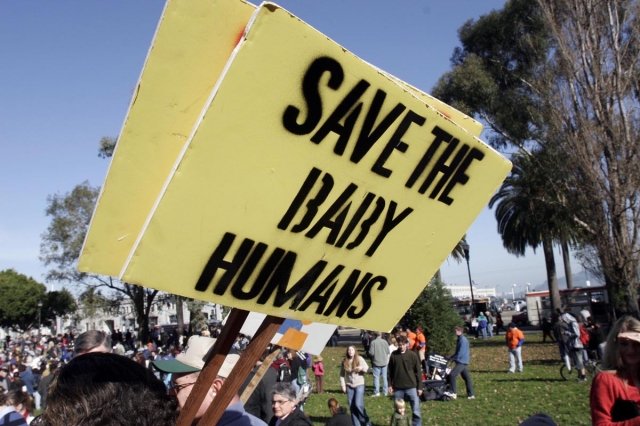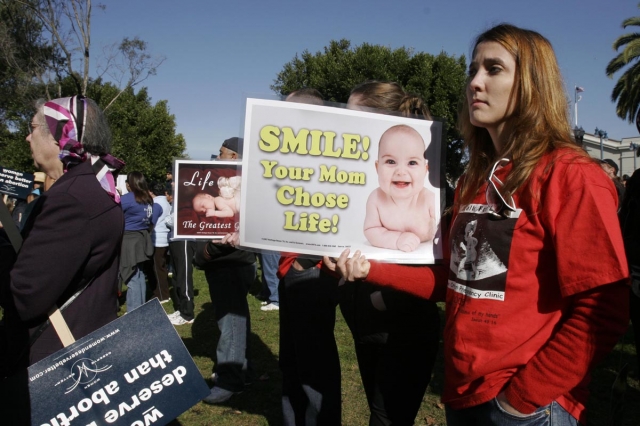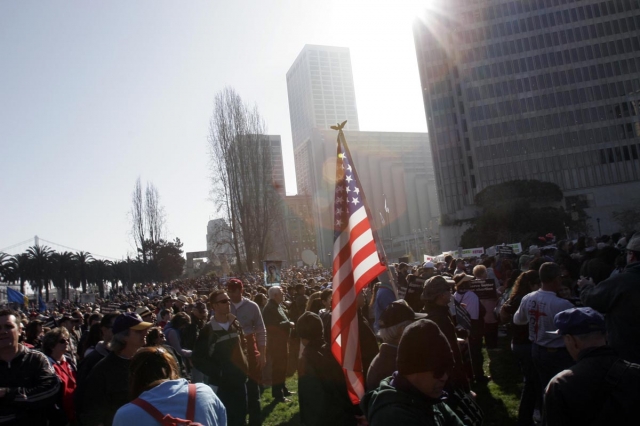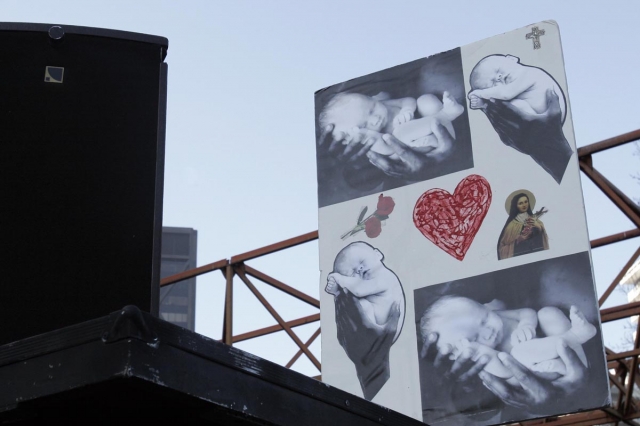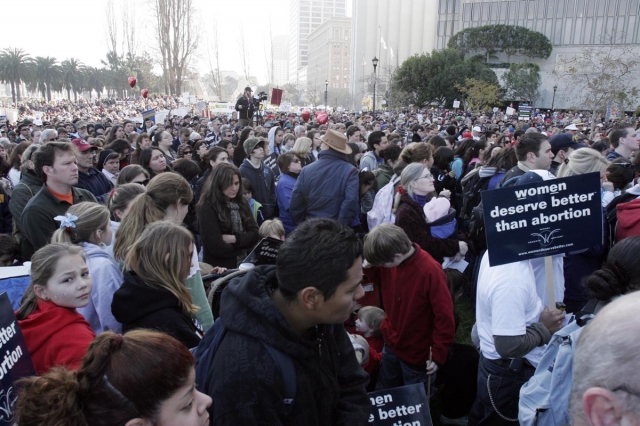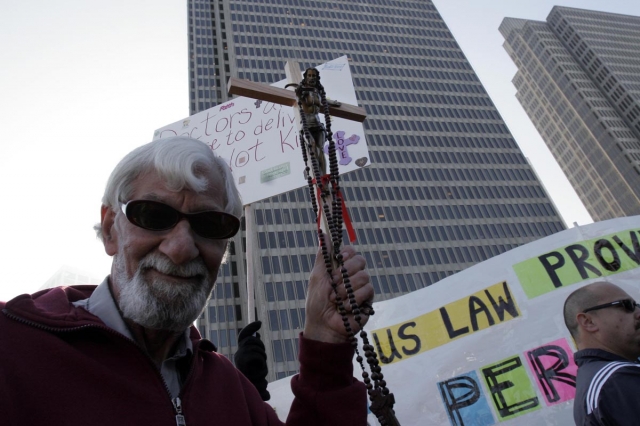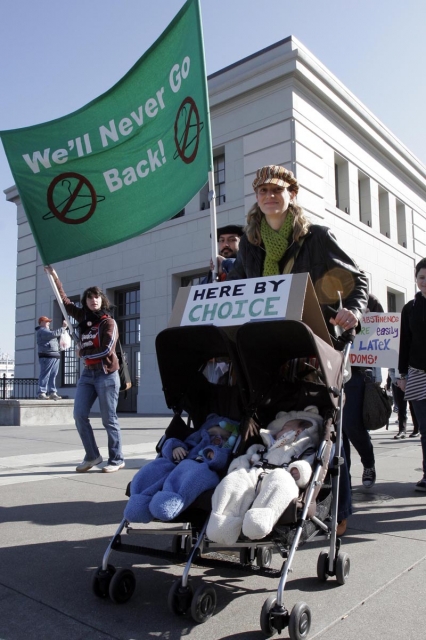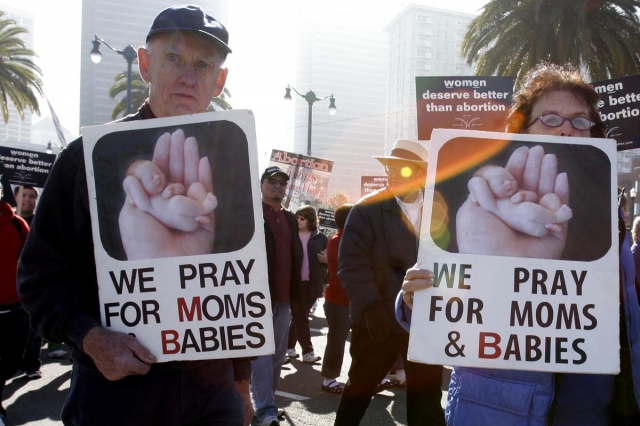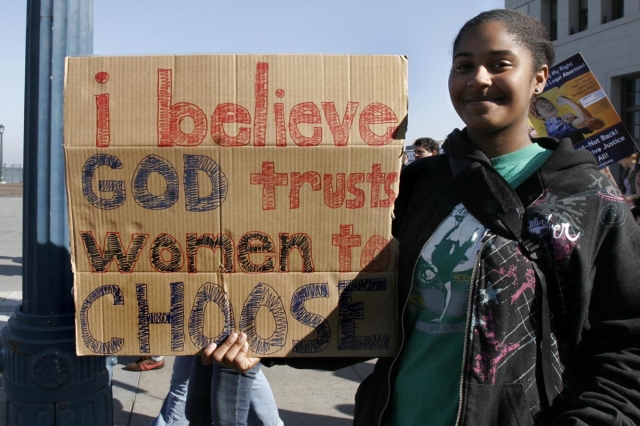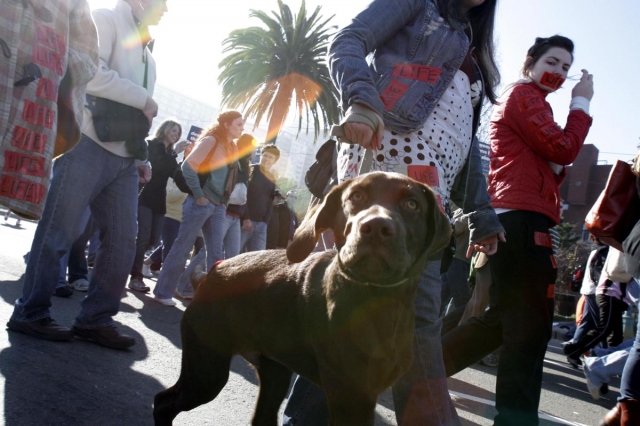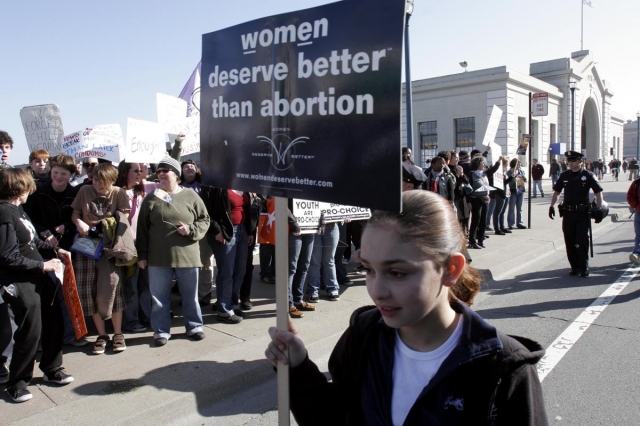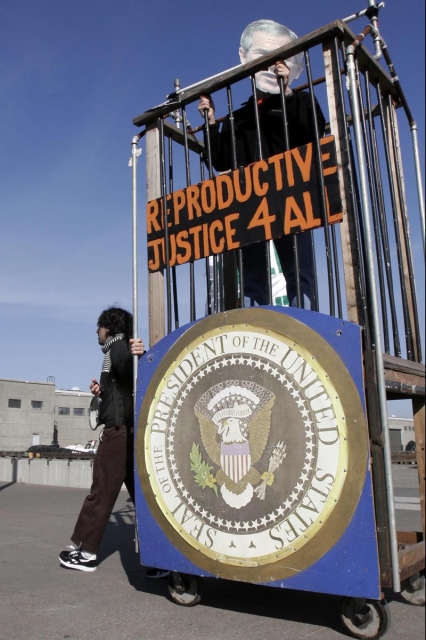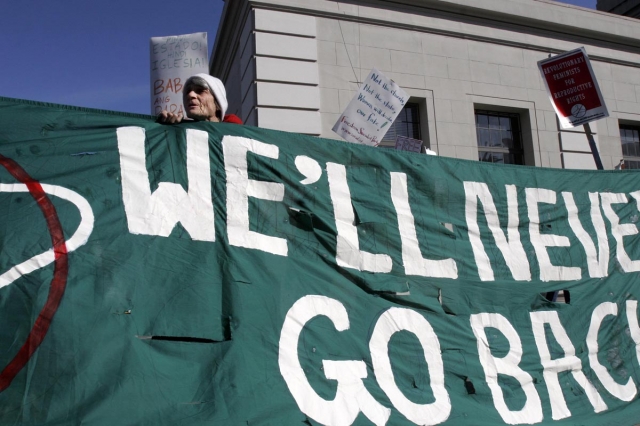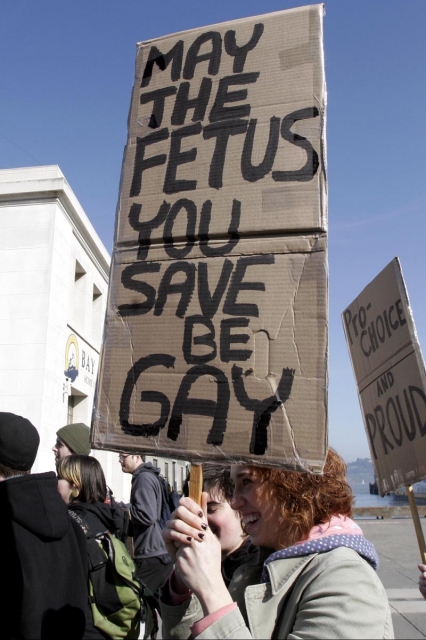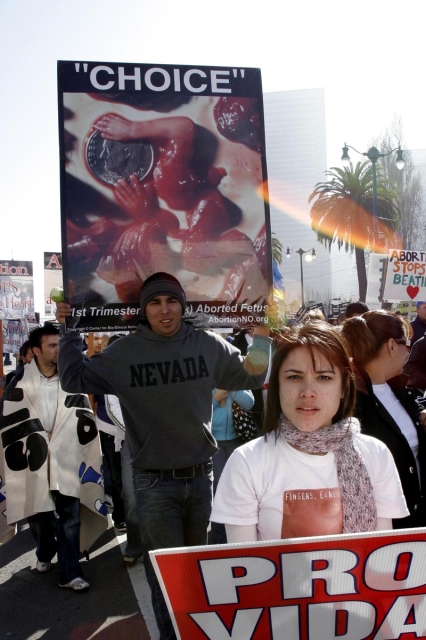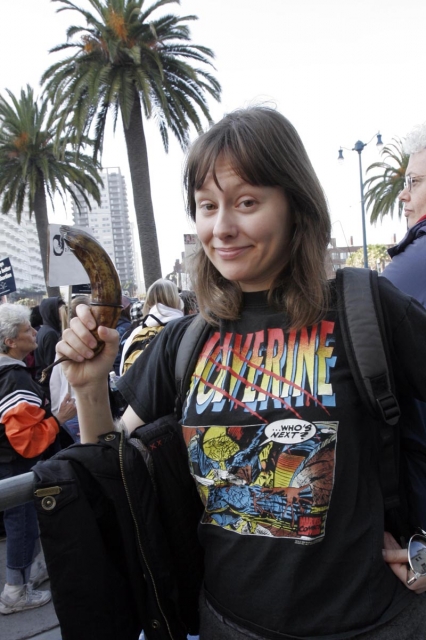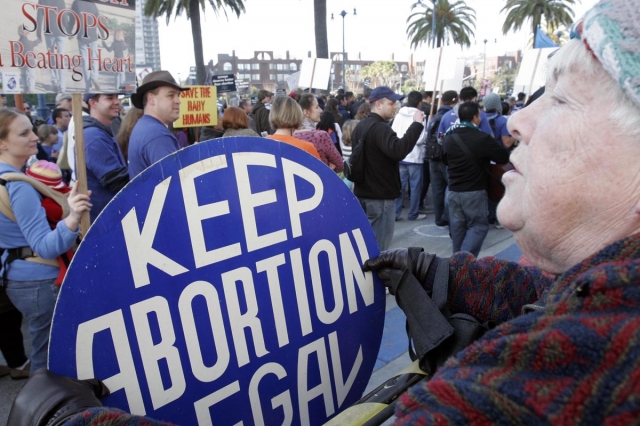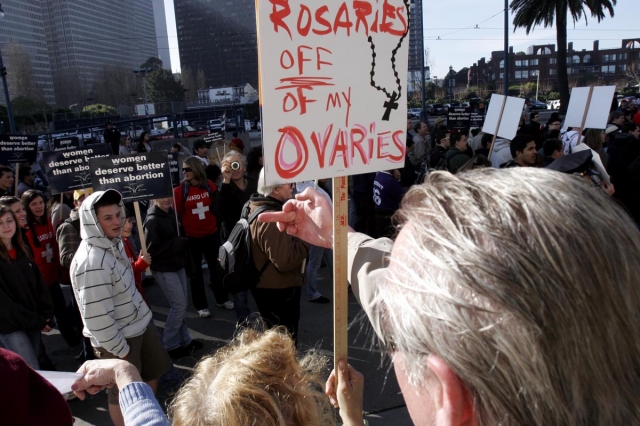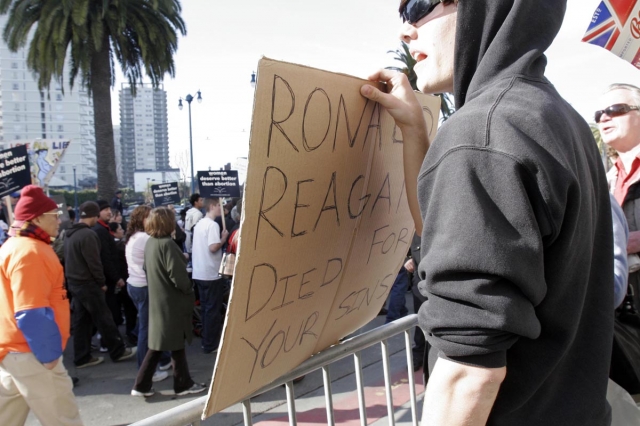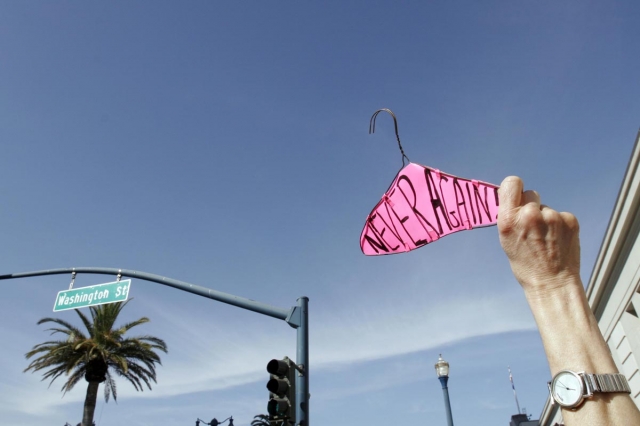From the Open-Publishing Calendar
From the Open-Publishing Newswire
Indybay Feature
PHOTOS: Abortion, for and against
At San Francisco's Embarcadero on January 19th 2008, thousands of anti-abortion demonstrators gathered to march in the "Walk for Life." Pro-choice counter demonstrators tailed the march and agitated from their own march on sidewalks.
At San Francisco's Embarcadero on January 19th 2008, thousands of anti-abortion demonstrators gathered to march in the "Walk for Life." Pro-choice counter demonstrators tailed the march and agitated from their own march on sidewalks.
For more information:
http://www.erinsiegal.com
Add Your Comments
Comments
(Hide Comments)
Patrice was one of three women who kick started the drive to totally legalize abortion in California in the sixties. She taught do it yourself abortion classes, handed out flyers, asking women if they knew where they could get abortion services and organized one of the most efficient abortion provider referral services in the nation- everything that she did led to the eventual relaxation of laws in California, demolished the unfair power that Doctors had over the decision making process and paved the way for for decisions like Roe v Wade. She started an organization that would later become NARAL.
She is a true heroine of this movement, and everyone who's active in reproductive justice should know about her (she's also incredibly modest about her achievements!) Read on:
The Society for Humane Abortion in California was one; "Jane" in Chicago was the other. Both challenged the state in the most fundamental way and made obvious what had long been true: illegal abortions were readily available to thousands, and the state was powerless to stop them. In creating their own illegal abortion networks, the California and Chicago projects circumvented the medical establishment and hinted at the possibility of a health-care system for women run by feminists in competition with the existing medical system. These initiatives were not at first identified as women's liberation efforts—that phrase had not been coined yet. The second wave of feminism, on the verge of breaking, would follow the analysis and activism of these innovative organizers.
One of the earliest nonelite supporters of the reform movement became one of the first critics of the professionals' reform strategy. In 1961, Patricia Maginnis, a San Francisco medical technician, collected petitions in support of a California bill to reform abortion law. She soon recognized, however, the practical and political limitations of reform. First, Maginnis saw that reform laws would not benefit the majority of women seeking abortions, and second, she concluded that writing restrictive "reforms" into law would make it more difficult to further liberalize access to abortion. As early as 1962, she voiced her objection to the type of review boards that the reform laws would institufionalize. Maginnis formed an organization to support reform legislation, but within a few years she and her organization, the Society for Humane Abortion (SHA), rejected reform.[18]
The society put women, rather than physicians, at the forefront. It exposed the medical review committees, which reform measures would make permanent legal institutions, as insulting and humiliating to women. The professionals who initiated the reform movement assumed that physicians would review women's abortion requests. The society criticized such a system. A woman's decision to have an abortion "should not be frustrated and delayed by the complex machinery of legislated abortion committees which sit in judgment of the woman," the SHA argued. "A decision to obtain an abortion should be treated just as any other surgical procedure, as a private matter between a patient and her physician."[19] In an SHA cartoon, a woman asked a psychiatrist, "How much does a psychosis cost for a legal abortion?" Psychiatrists, who had worked to help women obtain abortions, had come to be seen as barriers and were vilified for their role.[20]
The SHA helped radicalize the abortion discourse when it proclaimed abortion as a right and demanded repeal of abortion laws. "The termination of pregnancy," the organization declared, "is a deci-
― 224 ―
sion which the person or family involved should be free to make as their own religious beliefs, values, emotions, and circumstances may dictate." Furthermore, the group argued, abortions should be available, affordable, and provided in a way that was neither "humiliating nor discriminatory." SHA's perspective would be adopted by women's liberation groups and, ultimately, all sections of the feminist movement.[21] For the first time an American women's organization had framed the problem of abortion in terms of women's right to control their reproduction.[22]
In the mid-1960s, Maginnis created a parallel organization designed to help women obtain illegal abortions. Rather than cultivating friendly hospital abortion committees or teaching women what to say in order to get legal, therapeutic abortions, Maginnis challenged the law by running abortion classes and distributing leaflets on the streets of San Francisco with the names of abortionists in Mexico, Japan, and Sweden. By 1969, SHA's underground arm reported sending twelve thousand women outside the U.S. for abortion. Furthermore, it worked to make women who received referrals politically conscious by requiring them to write letters in support of repeal to their state legislators.[23] The group not only sent women to aborfionists, it regulated the illegal abortionists.[24] This project turned the tables on the legal abortion system: instead of women having to prove to physicians that they deserved abortions, physician-abortionists had to prove their trustworthiness to potential patients.
Like the SHA in California, what became known as "Jane" in Chicago had roots in a prefeminist era. It grew out of an information network within the Civil Rights and student movements of the mid-1960s. In 1965, Heather Booth found a doctor in the movement who agreed to perform an abortion for the sister of a male friend. Booth was a student at the University of Chicago and an activist; she had participated in sit-ins at Woolworth lunch counters in New York in support of black antisegregation efforts in the South and had registered black voters during Freedom Summer in Mississippi. Like many before her, including Guttmacher and Maginnis, Booth ended up giving out the name of the abortionist repeatedly and was soon overwhelmed by the demand for help and information. Since she was an organizer, Booth set out to find a group of women to take over this necessary work.[25] In 1967, several women active in movement politics created "The Service," which provided abortions to women without questioning the validity of their requests. The group included Hyde Park homemakers and
― 225 ―
University of Chicago students. As they gained control over the quality and prices of illegal abortion in Chicago, they formed an alternative, feminist, health-care system. When the activists negotiated with the abortionists to lower the price, they collectively imitated generations of women who had individually bargained with abortionists. They also set up a "scholarship" fund to help low-income women. Jane members initially delivered women to abortionists, but when they realized that some of the "doctors" were not physicians, they decided to learn how to perform abortions themselves.[26]
The Chicago Women's Liberation Union, a citywide coalition, advertised its abortion service through underground newspapers, women's liberation papers, and school papers. When a woman called the union about an abortion, she was given a local telephone number and told to ask for "Jane." After she left a message, a member returned her call, took her medical history, and arranged for her to talk with a counselor, who explained the abortion procedure and told her to go to an apartment called "the Front." There, service members prepared the woman for the procedure, took her temperature, and gave her antibiotics to prevent infections and a leaflet telling her what to do if she had complications. The Front served as a waiting room for the friends, relatives, and lovers who accompanied women seeking abortions, where they could talk or watch TV while snacking on cookies and coffee. From the Front, where by the early 1970s twenty or thirty people might be waiting, members of The Service drove carloads of women to another apartment where a Jane member gave each woman a local anesthetic and performed the dilation and curettage. A counselor held the woman's hand during the procedure. Between 1969 and 1973, Jane provided eleven or twelve thousand abortions, approximately three thousand per year. The women who went to The Service represented every age, racial, and ethnic group and every class. When New York legalized abortion, wealthier women flew there and The Service's clientele changed. As one woman recalled, "about 70 percent were women of color[,] most of whom were living on a subsistence wage or welfare with very poor health care." [27]
This abortion service was similar to other illegal abortion clinics, but different because of its feminist and radical political orientation. Jane was both a health service and a political education project. Not only did Jane eliminate the profit in illegal abortion as it brought abortion under feminist control, it eliminated the judgments of male physicians and the sexual harassment that sometimes occurred. The activists in
― 226 ―
The Service provided for women's health needs within an environment designed for women. They sought to empower women through knowledge of their own bodies: during appointments, Jane members provided handmirrors to enable the women to see their cervixes and gave each woman a copy of Our Bodies, Ourselves . The activists rejected the authority and distance adopted by physicians as well as the white lab coats; instead they wore jeans and talked with their "patients" as sisters and as equals. [28]
Although The Service expanded beyond the movement, it could be incomprehensible to someone outside the movement that sponsored it. What was an advance for activists in the women's health movement—the rejection of male medical authority and the acquisition of knowl-edge—disconcerted some patients. One woman later interviewed about Jane had a negative memory of her abortion experience: it took a long time; it was painful; she doubted their skill. That she went to an apartment rather than a hospital or physician's office, that the furniture was shabby, that the abortion was performed in a bedroom, and that the woman who aborted her wore jeans bothered her. Medical offices and white uniforms reassured women that they were getting good medical care; the lack of these symbols suggested that the whole operation was dirty, illegal, and probably dangerous. This woman's negative reaction may have reflected racial and class differences as well as familial religious opposition to abortion. She was an African American going to a mostly white group; she had not graduated from high school, let alone entered college; and her boyfriend's grandmother had been pressuring her to have the baby. [29] An outsider might see the service as a hippie operation and, though essential, distressing despite the counselors and cookies.
The policing of criminal abortion, which received no attention from the professional reformers, figured importantly in the feminist critique of the abortion system. The SHA and Jane warned women of the conventional police methods used for investigating abortion and criticized the surveillance conducted by hospital staff for the state. Every year in the early 1960s, San Francisco hospitals reported to the police over a hundred women who had abortions. Jane members recalled that hospital emergency room staff called police before aiding women in the process of aborting: "Sometimes they would admit a woman and then withhold drugs from her unless she talked." [30] The voluntary policing by medical practitioners helped produce the rage many feminists felt toward the medical profession. Activists advised women who had abortions that they had a right to refuse to answer the questions of police. [31] (See plate 6.)
― 227 ―
image
[Full Size]
Plate 6. "The D.A.'s Peeping Toms." This feminist cartoon suggests that the
investigation and prosecution of abortion provided voyeuristic sexual pleasures
for men. It represented the perspective of women who had illegal abortions and
feared being discovered and observed by police in precisely this way. Patricia T.
Maginnis, The Abortees' Songbook , 1969, Positions Papers part 2 folder, WEF.
Reproduced with permission of Patricia T. Maginnis and of the C. D. McCormick
Library of Special Collections, Northwestern University Library.
By the mid-1960s, women across the country had organized themselves into a number of organizations calling for the equality and liberty of women. [32] Jane and the SHA were formed earlier and became part of this second wave of feminism. Older women active in the 1950s and early 1960s in trade unions and state women's commissions formed NOW, the National Organization for Women, in 1966. NOW empha-
― 228 ―
sized ending sex discrimination in hiring, wages, education, and the media. NOW membership was primarily white, but the stereotypical depiction of NOW as exclusively professional and middle-class is incorrect. [33] At about the same time, poor women—African Americans prominent among them—organized themselves in the National Welfare Rights Organization. [34]
Simultaneously, a group of younger women involved in protest movements ranging from black voter-registration drives in the South to the anti-Vietnam War movement began to examine their dissatisfaction within these movements and to reconsider what the Left had long called "the woman question." In 1967 and 1968, small groups soon named "women's liberation" groups arose separately in a number of cities, including Chicago. These groups generally saw themselves as on the Left, preferred militant tactics to lobbying, and although they had national ties, meetings, and marches, worked locally in decentralized groups. They took up the "personal" issues of relationships between men and women, sexuality, and housework and reanalyzed them as collective and, thus, "political" problems. [35] White women dominated these groups, but women of color, sometimes calling themselves "third-world" feminists, also joined them, and black women's liberation groups arose within radical African American protest organizations as well. [36]
Questions about sexuality were particularly salient for young movement women experiencing the "sexual revolution." As young women shared their experiences in consciousness-raising groups, they identified the power relations embedded in sex. Too many men on the Left had made it plain at national meetings and in more intimate encounters that they regarded women as sex objects who were to serve their sexual pleasures as well as their coffee. Some of these insulting (and later infamous) remarks helped inspire the formation of women's liberation groups. The realization among women that they had been sexually exploited, ignored, or even assaulted, instead of pleasured, fueled discussions. In consciousness-raising groups, women learned together that female sexual pleasure was a political issue—the clitoral orgasm had been denied by medical experts and replaced by the intercourse-directed "vaginal orgasm" that conveniently guaranteed male orgasm. They discussed their fears of unwanted pregnancy and their need for effective, safe birth control and abortion. They analyzed heterosexuality itself as a social construction and reconsidered their attractions to women. Lesbians and gay men "came out" and declared their sexuality with pride. All of these issues added up to a recognition of the contra-
― 229 ―
dictions within the new sexual "revolution," but not a retreat from the hope of sexual freedom. These feminists did not want to eliminate sexual freedom in order to avoid having to cope with its difficulties, as advocated by the New Right in the 1970s and 1980s. Their demands pointed to feminist desire to enjoy their sexuality and to make their sexual relations with men or women better. [37]
Abortion was part of this radical feminist analysis of sexual freedom because it had real, material importance in women's lives and because it had symbolic significance. Women had used abortion for generations, but feminists articulated a new analysis of legal, available abortion as fundamental to female freedom. The prohibition of abortion, they argued, forced women to bear children; the state's enforcement of motherhood exemplified the oppression of women. Even though abortion initially divided some groups, feminists across the political spectrum came to support the decriminalization of abortion, [38] just as the diverse organizations which made up the nineteenth-century woman's movement had agreed on voluntary motherhood. The new feminist argument for abortion extended the analyses of earlier feminists. Nine-teenth-century feminists rejected involuntary motherhood and agreed on the importance of women's right to refuse the sexual advances of their husbands. Emma Goldman and Sanger went a step further in their analysis of the importance of contraception: without the ability to avoid pregnancy, women could not enjoy (heterosexual) sex or control their own lives. [39] Yet no contraceptive, not even "the pill" introduced in 1960, was 100 percent effective. Furthermore, birth control was hard to get, especially for the unmarried, and some men refused to use it. When women faced unwanted pregnancies, hundreds of thousands of them, married and unmarried, both in the movement and in the mainstream, searched for abortions. Women who never had an abortion needed it as a backup. Abortion was actually used, potentially needed, and representative of women's sexual and reproductive freedom. Each of these meanings underpinned feminist support for legal and accessible abortion.
Feminists not only redefined abortion, they created new tactics. Most important for changing the course of the debate and politics, feminists designated women as the experts on abortion. They rejected the assumption that (almost exclusively) male physicians, religious leaders, philosophers, or politicians had the expertise, authority, or right to decide when an abortion could be performed. At speak-outs, women stood up and declared that they had had illegal abortions. The speak-
― 230 ―
out was an important political tactic, for it took abortion out of the realm of private secrets and made it an issue that women could talk about in public. [40] This was not the first time that American women discussed abortion—for they had long talked about it at home, at work, and in the offices of doctors, nurses, and midwives—but it was the first time that they admitted their own abortions in political arenas. In openly discussing abortions, women erased the shame and secrecy surrounding abortion. The speak-outs made clear that abortion was not a personal problem, but a problem for all women arising from the double standard. As women shared their stories, they created new knowledge and educated politicians, the medical profession, the judiciary, and the general public about why women needed abortions and the problems of abortion, both illegal and legal.
The emphasis on planning that the birth control movement adopted in the 1940s would haunt the movement to decriminalize abortion. The movement's new name, "Planned Parenthood," implied that planned children were better and unplanned children undesirable. Exercising such control, however, was a middle-class privilege and virtue. [41] Many, particularly in the working class, did not "plan" their families and did not necessarily regard an unplanned pregnancy or an unplanned child as unwanted. The emphasis on family planning had the unfortunate result of suggesting that everyone should carry out their sex lives and create families in a rational manner and that "accidental" childbearing was reprehensible. This induced guilt (and anger) among middle-class women, who do not always act with foresight but believe that they should, and among low-income women and men, who sense disapproval of their families. Outsiders blamed the children of the poor for their poverty, rather than placing the blame on the economic system or the racism and sexism that denied them well-paid jobs.
Population controllers entered the abortion discourse with a different analysis: they favored legal abortion to combat "overpopulation," a problem they located in low-income and "nonwhite" neighborhoods and third-world countries. As Linda Gordon has pointed out, population control and feminism had different roots. The former was rooted in imperialism and institutionalized in U.S. foreign policy in the 1950s and 1960s to control third-world populations and avert insurrections. The latter was rooted in a desire to combat the oppression of women. Unfortunately, however, the main birth control organization, Planned Parenthood Federation of America, suppressed its feminist origins and joined in the promotion of worldwide population control measures, thus powerfully linking birth control and population control. Popula-
― 231 ―
tion control programs did not emphasize women's rights to make decisions about childbearing, but imposed government-sponsored programs to cut the fertility of the poor. Many new environmentalists picked up the theory of the impending population explosion and embraced population control in the name of protecting the earth from destruction. [42] Demonstrating the popularity of these ideas, in 1970 Senator Robert Packwood (R. Ore.) introduced a bill into Congress to liberalize the abortion laws as a solution to the perceived "population explosion." [43]
At the same time, Planned Parenthood worked to provide birth control services to low-income, urban women of color. Though many low-income black women desperately wanted birth control, the provision of these services often made them feel pressured to accept contraceptives. In Pittsburgh, for example, Planned Parenthood staff advertised their clinic by going door-to-door in poor neighborhoods with the result, said a physician for the NAACP, that many African Americans "feel that they'd better obey 'official suggestions' to visit a birth control clinic or risk losing their monthly welfare check." [44]
Some state officials pushed policies to sterilize poor women. In Illinois, one legislator proposed that welfare recipients be forced "off public aid or undergo sterilization operations if they have more than two children." This legislator did not question the justice of using political power to regulate both the reproduction and the sexual behavior of low-income women. His bill intended to reduce the numbers of the low-income population (and, specifically, if not explicitly, reduce the black population with which welfare had become identified). The bill was defeated, but a message about the official desire to sterilize African Americans had been sent nonetheless. [45]
Urban black nationalists recognized the underlying racism of population controllers and the fears of poor African Americans and renamed birth control, and then abortion, "black genocide." The fear of birth control as a method of racist oppression designed to eliminate this minority population and its political power were mainly located among poor, urban African Americans. [46] Educated African Americans and their organizations had promoted birth control since the early twentieth century, but they too criticized the racism underlying many birth control programs. [47]
Some black nationalists called for the production of more babies, not fewer. One spokesman of an "ultra-militant" New York group (as Ebony described him) remarked, "See that sister there? She's having another baby for me. I need an army, and this is how we're going to get
― 232 ―
it." [48] In the war for black political power, African American women were assigned a role based on their biological capacity and traditional female gender expectations: their job was to reproduce and nurture future soldiers. Black health-care workers pointed out that men feared birth control, not only because of their stated concern about genocide, but because they feared that contraceptives could free female sexuality. [49] Black nationalist men had sexism in common with white men on the Left and the Right. [50]
Feminists of color struggled over these issues with the men of their own racial groups and with white feminists; on the one hand, they fought sexism, on the other, racism. African American and Latina feminists brought the issues of genocide and sterilization to the forefront of feminist attention and rejected the notion that the revolutionary. role for black women was to have more babies. "Breeding revolutionaries," Florynce Kennedy commented, "is not too far removed from a cultural past where Black women were encouraged to be breeding machines for their slave masters." The nationalist indictment of contraceptives and abortion as "genocidal" was, Congresswoman Shirley Chisolm believed, "male rhetoric, for male ears." She pointed to the high level of injury and death resulting from illegal abortion among black and Puerto Rican women and advocated legal and accessible birth control and abortion for all. [51]
Third-world feminists made opposition to forced sterilization part of the campaign to repeal the abortion laws. African American women in the Women's National Abortion Action Coalition consistently raised the issue of sterilization abuse. Radical segments of the feminist movement, including the Chicago Women's Liberation Union, heard the charges of black genocide and adopted positions against sterilization abuse. The reproductive rights wing of the abortion movement supported the right to bear children as well as the right to avoid childbearing and demanded all of the services that would make such freedom in childbearing possible. [52] Antiracist and oppositional voices pushed the abortion rights movement to recognize that abortion was not the only issue, but never controlled the movement.
A multitude of groups formed on every level—at the national, regional, state, city, professional, church, and campus levels—to decriminalize abortion. Permanent organizations formed that still exist, and many more ephemeral organizations popped up everywhere. The National Association for the Repeal of Abortion Laws (NARAL) was formed in 1969, and Dr. Ed Keemer became its Midwest vice president. [53] Clergymen from numerous denominations created a national
― 233 ―
clergy abortion referral service. [54] Women ran an "underground railroad," driving women from southern states to Chicago to get abortions. [55] Students at a Catholic women's college in Chicago formed a chapter of the Women's National Abortion Action Coalition (WONAAC); though the administration opposed them, "several nuns privately expressed their support." [56] In 1970, women's, medical, trade union, socialist, and population control organizations joined under one banner for "Total Repeal of Illinois Abortion Laws." [57]
By 1968, the various branches oft he abortion rights movement had adopted the feminist position that the abortion laws had to be repealed. This marked a significant shift in the thinking of the professional movement. Public debate, the new women's movement, and political events pushed doctors, with much of the rest of American society, in directions they previously would not have imagined possible. California passed the ALI model law in 1967, but a year later it was clear that reform was a failure and repeal necessary. The law had made the therapeutic abortion system inflexible. Instead of freeing doctors to perform more therapeutic abortions, reform laws further enchained doctors to the committee system. Where before the legal vagueness enabled different hospital committees to allow therapeutic abortions for a variety of reasons, now the law delineated the acceptable indications and left no room for interpretation. Furthermore, California state officials had initiated a campaign to punish physicians for participating in abortion. Secret investigations resulted in charges against nine physicians. A raid on an abortion clinic revealed that a California doctor referred patients there; Dr. Leon Belous, a public supporter of liberalizing the abortion laws, was prosecuted and convicted in 1968 for referring a woman to that abortion clinic. [58]
Dr. Alan Guttmacher may serve as an example of the transformation of liberal professional thinking. Guttmacher's biography mirrored the political history of abortion. He had been uncomfortable with medical teaching on abortion since the late 1920s, but senior obstetricians silenced his criticism in the 1930s. In the early 1950s, he instituted therapeutic abortion committees, hoping to eliminate the arbitrariness of abortion decisions, only to become frustrated later with the mechanisms he helped create. Guttmacher participated in the professional reform movement at its start and was an outspoken public advocate for legal change since the late 1950s, but until 1968, he opposed repeal as too radical. Both his willingness to challenge abortion policy and his relative slowness to accept the idea of repealing the abortion laws were shaped by his profession. He urged reform because, as an obstetrician,
― 234 ―
he had seen the horrendous results of the criminal abortion laws, yet his professional assumptions made him prefer limited reform. He was a radical within a conservative specialty. The movement and the results of reform changed his mind. After being appointed by New York Governor Nelson Rockefeller to a state commission on abortion, Guttmacher stopped arguing for halfway reform measures. "I changed my mind and I am in your camp," he told one feminist correspondent who questioned his position; "abortion on demand is the only civilized way to handle the problem." [59]
The medical profession organized to criminalize abortion in the mid-nineteenth century and to oppose those very laws a century later. The nineteenth-century regular medical profession had derived authority by proclaiming its moral superiority and by positioning itself as paternalistic arbiters over female reproductive behavior. A hundred years later, the profession enjoyed enormous social authority. [60] Yet as the abortion laws restricted and monitored medical practice, they undermined medical autonomy. By the late 1960s, esteemed members of the profession no longer needed to attack abortion to prove their purity and could challenge laws promoted by their fore bears without having their reputations questioned.
The legalization of abortion gained great medical and popular support in these years. When a Chicago television station made a medical debate on Illinois abortion law reform into a referendum in 1967, the "votes" showed high support for reform. [61] An early survey of New York obstetricians and gynecologists found that an overwhelming majority, 85 percent, supported the ALI model law, and in 1968 the American College of Obstetricians and Gynecologists approved the liberalization of abortion laws along reform lines. [62] Psychiatrists, black medical societies, and the American Public Health Association went further: they supported repeal. [63] The American Public Health Association advocated public funding of abortion to ensure its availability to all women. [64] 1969 polls found that the majority of physicians supported repeal of the criminal abortion laws and the majority of Americans, including most Catholics, believed abortion should be a private decision. [65]
previous sub-section
She is a true heroine of this movement, and everyone who's active in reproductive justice should know about her (she's also incredibly modest about her achievements!) Read on:
The Society for Humane Abortion in California was one; "Jane" in Chicago was the other. Both challenged the state in the most fundamental way and made obvious what had long been true: illegal abortions were readily available to thousands, and the state was powerless to stop them. In creating their own illegal abortion networks, the California and Chicago projects circumvented the medical establishment and hinted at the possibility of a health-care system for women run by feminists in competition with the existing medical system. These initiatives were not at first identified as women's liberation efforts—that phrase had not been coined yet. The second wave of feminism, on the verge of breaking, would follow the analysis and activism of these innovative organizers.
One of the earliest nonelite supporters of the reform movement became one of the first critics of the professionals' reform strategy. In 1961, Patricia Maginnis, a San Francisco medical technician, collected petitions in support of a California bill to reform abortion law. She soon recognized, however, the practical and political limitations of reform. First, Maginnis saw that reform laws would not benefit the majority of women seeking abortions, and second, she concluded that writing restrictive "reforms" into law would make it more difficult to further liberalize access to abortion. As early as 1962, she voiced her objection to the type of review boards that the reform laws would institufionalize. Maginnis formed an organization to support reform legislation, but within a few years she and her organization, the Society for Humane Abortion (SHA), rejected reform.[18]
The society put women, rather than physicians, at the forefront. It exposed the medical review committees, which reform measures would make permanent legal institutions, as insulting and humiliating to women. The professionals who initiated the reform movement assumed that physicians would review women's abortion requests. The society criticized such a system. A woman's decision to have an abortion "should not be frustrated and delayed by the complex machinery of legislated abortion committees which sit in judgment of the woman," the SHA argued. "A decision to obtain an abortion should be treated just as any other surgical procedure, as a private matter between a patient and her physician."[19] In an SHA cartoon, a woman asked a psychiatrist, "How much does a psychosis cost for a legal abortion?" Psychiatrists, who had worked to help women obtain abortions, had come to be seen as barriers and were vilified for their role.[20]
The SHA helped radicalize the abortion discourse when it proclaimed abortion as a right and demanded repeal of abortion laws. "The termination of pregnancy," the organization declared, "is a deci-
― 224 ―
sion which the person or family involved should be free to make as their own religious beliefs, values, emotions, and circumstances may dictate." Furthermore, the group argued, abortions should be available, affordable, and provided in a way that was neither "humiliating nor discriminatory." SHA's perspective would be adopted by women's liberation groups and, ultimately, all sections of the feminist movement.[21] For the first time an American women's organization had framed the problem of abortion in terms of women's right to control their reproduction.[22]
In the mid-1960s, Maginnis created a parallel organization designed to help women obtain illegal abortions. Rather than cultivating friendly hospital abortion committees or teaching women what to say in order to get legal, therapeutic abortions, Maginnis challenged the law by running abortion classes and distributing leaflets on the streets of San Francisco with the names of abortionists in Mexico, Japan, and Sweden. By 1969, SHA's underground arm reported sending twelve thousand women outside the U.S. for abortion. Furthermore, it worked to make women who received referrals politically conscious by requiring them to write letters in support of repeal to their state legislators.[23] The group not only sent women to aborfionists, it regulated the illegal abortionists.[24] This project turned the tables on the legal abortion system: instead of women having to prove to physicians that they deserved abortions, physician-abortionists had to prove their trustworthiness to potential patients.
Like the SHA in California, what became known as "Jane" in Chicago had roots in a prefeminist era. It grew out of an information network within the Civil Rights and student movements of the mid-1960s. In 1965, Heather Booth found a doctor in the movement who agreed to perform an abortion for the sister of a male friend. Booth was a student at the University of Chicago and an activist; she had participated in sit-ins at Woolworth lunch counters in New York in support of black antisegregation efforts in the South and had registered black voters during Freedom Summer in Mississippi. Like many before her, including Guttmacher and Maginnis, Booth ended up giving out the name of the abortionist repeatedly and was soon overwhelmed by the demand for help and information. Since she was an organizer, Booth set out to find a group of women to take over this necessary work.[25] In 1967, several women active in movement politics created "The Service," which provided abortions to women without questioning the validity of their requests. The group included Hyde Park homemakers and
― 225 ―
University of Chicago students. As they gained control over the quality and prices of illegal abortion in Chicago, they formed an alternative, feminist, health-care system. When the activists negotiated with the abortionists to lower the price, they collectively imitated generations of women who had individually bargained with abortionists. They also set up a "scholarship" fund to help low-income women. Jane members initially delivered women to abortionists, but when they realized that some of the "doctors" were not physicians, they decided to learn how to perform abortions themselves.[26]
The Chicago Women's Liberation Union, a citywide coalition, advertised its abortion service through underground newspapers, women's liberation papers, and school papers. When a woman called the union about an abortion, she was given a local telephone number and told to ask for "Jane." After she left a message, a member returned her call, took her medical history, and arranged for her to talk with a counselor, who explained the abortion procedure and told her to go to an apartment called "the Front." There, service members prepared the woman for the procedure, took her temperature, and gave her antibiotics to prevent infections and a leaflet telling her what to do if she had complications. The Front served as a waiting room for the friends, relatives, and lovers who accompanied women seeking abortions, where they could talk or watch TV while snacking on cookies and coffee. From the Front, where by the early 1970s twenty or thirty people might be waiting, members of The Service drove carloads of women to another apartment where a Jane member gave each woman a local anesthetic and performed the dilation and curettage. A counselor held the woman's hand during the procedure. Between 1969 and 1973, Jane provided eleven or twelve thousand abortions, approximately three thousand per year. The women who went to The Service represented every age, racial, and ethnic group and every class. When New York legalized abortion, wealthier women flew there and The Service's clientele changed. As one woman recalled, "about 70 percent were women of color[,] most of whom were living on a subsistence wage or welfare with very poor health care." [27]
This abortion service was similar to other illegal abortion clinics, but different because of its feminist and radical political orientation. Jane was both a health service and a political education project. Not only did Jane eliminate the profit in illegal abortion as it brought abortion under feminist control, it eliminated the judgments of male physicians and the sexual harassment that sometimes occurred. The activists in
― 226 ―
The Service provided for women's health needs within an environment designed for women. They sought to empower women through knowledge of their own bodies: during appointments, Jane members provided handmirrors to enable the women to see their cervixes and gave each woman a copy of Our Bodies, Ourselves . The activists rejected the authority and distance adopted by physicians as well as the white lab coats; instead they wore jeans and talked with their "patients" as sisters and as equals. [28]
Although The Service expanded beyond the movement, it could be incomprehensible to someone outside the movement that sponsored it. What was an advance for activists in the women's health movement—the rejection of male medical authority and the acquisition of knowl-edge—disconcerted some patients. One woman later interviewed about Jane had a negative memory of her abortion experience: it took a long time; it was painful; she doubted their skill. That she went to an apartment rather than a hospital or physician's office, that the furniture was shabby, that the abortion was performed in a bedroom, and that the woman who aborted her wore jeans bothered her. Medical offices and white uniforms reassured women that they were getting good medical care; the lack of these symbols suggested that the whole operation was dirty, illegal, and probably dangerous. This woman's negative reaction may have reflected racial and class differences as well as familial religious opposition to abortion. She was an African American going to a mostly white group; she had not graduated from high school, let alone entered college; and her boyfriend's grandmother had been pressuring her to have the baby. [29] An outsider might see the service as a hippie operation and, though essential, distressing despite the counselors and cookies.
The policing of criminal abortion, which received no attention from the professional reformers, figured importantly in the feminist critique of the abortion system. The SHA and Jane warned women of the conventional police methods used for investigating abortion and criticized the surveillance conducted by hospital staff for the state. Every year in the early 1960s, San Francisco hospitals reported to the police over a hundred women who had abortions. Jane members recalled that hospital emergency room staff called police before aiding women in the process of aborting: "Sometimes they would admit a woman and then withhold drugs from her unless she talked." [30] The voluntary policing by medical practitioners helped produce the rage many feminists felt toward the medical profession. Activists advised women who had abortions that they had a right to refuse to answer the questions of police. [31] (See plate 6.)
― 227 ―
image
[Full Size]
Plate 6. "The D.A.'s Peeping Toms." This feminist cartoon suggests that the
investigation and prosecution of abortion provided voyeuristic sexual pleasures
for men. It represented the perspective of women who had illegal abortions and
feared being discovered and observed by police in precisely this way. Patricia T.
Maginnis, The Abortees' Songbook , 1969, Positions Papers part 2 folder, WEF.
Reproduced with permission of Patricia T. Maginnis and of the C. D. McCormick
Library of Special Collections, Northwestern University Library.
By the mid-1960s, women across the country had organized themselves into a number of organizations calling for the equality and liberty of women. [32] Jane and the SHA were formed earlier and became part of this second wave of feminism. Older women active in the 1950s and early 1960s in trade unions and state women's commissions formed NOW, the National Organization for Women, in 1966. NOW empha-
― 228 ―
sized ending sex discrimination in hiring, wages, education, and the media. NOW membership was primarily white, but the stereotypical depiction of NOW as exclusively professional and middle-class is incorrect. [33] At about the same time, poor women—African Americans prominent among them—organized themselves in the National Welfare Rights Organization. [34]
Simultaneously, a group of younger women involved in protest movements ranging from black voter-registration drives in the South to the anti-Vietnam War movement began to examine their dissatisfaction within these movements and to reconsider what the Left had long called "the woman question." In 1967 and 1968, small groups soon named "women's liberation" groups arose separately in a number of cities, including Chicago. These groups generally saw themselves as on the Left, preferred militant tactics to lobbying, and although they had national ties, meetings, and marches, worked locally in decentralized groups. They took up the "personal" issues of relationships between men and women, sexuality, and housework and reanalyzed them as collective and, thus, "political" problems. [35] White women dominated these groups, but women of color, sometimes calling themselves "third-world" feminists, also joined them, and black women's liberation groups arose within radical African American protest organizations as well. [36]
Questions about sexuality were particularly salient for young movement women experiencing the "sexual revolution." As young women shared their experiences in consciousness-raising groups, they identified the power relations embedded in sex. Too many men on the Left had made it plain at national meetings and in more intimate encounters that they regarded women as sex objects who were to serve their sexual pleasures as well as their coffee. Some of these insulting (and later infamous) remarks helped inspire the formation of women's liberation groups. The realization among women that they had been sexually exploited, ignored, or even assaulted, instead of pleasured, fueled discussions. In consciousness-raising groups, women learned together that female sexual pleasure was a political issue—the clitoral orgasm had been denied by medical experts and replaced by the intercourse-directed "vaginal orgasm" that conveniently guaranteed male orgasm. They discussed their fears of unwanted pregnancy and their need for effective, safe birth control and abortion. They analyzed heterosexuality itself as a social construction and reconsidered their attractions to women. Lesbians and gay men "came out" and declared their sexuality with pride. All of these issues added up to a recognition of the contra-
― 229 ―
dictions within the new sexual "revolution," but not a retreat from the hope of sexual freedom. These feminists did not want to eliminate sexual freedom in order to avoid having to cope with its difficulties, as advocated by the New Right in the 1970s and 1980s. Their demands pointed to feminist desire to enjoy their sexuality and to make their sexual relations with men or women better. [37]
Abortion was part of this radical feminist analysis of sexual freedom because it had real, material importance in women's lives and because it had symbolic significance. Women had used abortion for generations, but feminists articulated a new analysis of legal, available abortion as fundamental to female freedom. The prohibition of abortion, they argued, forced women to bear children; the state's enforcement of motherhood exemplified the oppression of women. Even though abortion initially divided some groups, feminists across the political spectrum came to support the decriminalization of abortion, [38] just as the diverse organizations which made up the nineteenth-century woman's movement had agreed on voluntary motherhood. The new feminist argument for abortion extended the analyses of earlier feminists. Nine-teenth-century feminists rejected involuntary motherhood and agreed on the importance of women's right to refuse the sexual advances of their husbands. Emma Goldman and Sanger went a step further in their analysis of the importance of contraception: without the ability to avoid pregnancy, women could not enjoy (heterosexual) sex or control their own lives. [39] Yet no contraceptive, not even "the pill" introduced in 1960, was 100 percent effective. Furthermore, birth control was hard to get, especially for the unmarried, and some men refused to use it. When women faced unwanted pregnancies, hundreds of thousands of them, married and unmarried, both in the movement and in the mainstream, searched for abortions. Women who never had an abortion needed it as a backup. Abortion was actually used, potentially needed, and representative of women's sexual and reproductive freedom. Each of these meanings underpinned feminist support for legal and accessible abortion.
Feminists not only redefined abortion, they created new tactics. Most important for changing the course of the debate and politics, feminists designated women as the experts on abortion. They rejected the assumption that (almost exclusively) male physicians, religious leaders, philosophers, or politicians had the expertise, authority, or right to decide when an abortion could be performed. At speak-outs, women stood up and declared that they had had illegal abortions. The speak-
― 230 ―
out was an important political tactic, for it took abortion out of the realm of private secrets and made it an issue that women could talk about in public. [40] This was not the first time that American women discussed abortion—for they had long talked about it at home, at work, and in the offices of doctors, nurses, and midwives—but it was the first time that they admitted their own abortions in political arenas. In openly discussing abortions, women erased the shame and secrecy surrounding abortion. The speak-outs made clear that abortion was not a personal problem, but a problem for all women arising from the double standard. As women shared their stories, they created new knowledge and educated politicians, the medical profession, the judiciary, and the general public about why women needed abortions and the problems of abortion, both illegal and legal.
The emphasis on planning that the birth control movement adopted in the 1940s would haunt the movement to decriminalize abortion. The movement's new name, "Planned Parenthood," implied that planned children were better and unplanned children undesirable. Exercising such control, however, was a middle-class privilege and virtue. [41] Many, particularly in the working class, did not "plan" their families and did not necessarily regard an unplanned pregnancy or an unplanned child as unwanted. The emphasis on family planning had the unfortunate result of suggesting that everyone should carry out their sex lives and create families in a rational manner and that "accidental" childbearing was reprehensible. This induced guilt (and anger) among middle-class women, who do not always act with foresight but believe that they should, and among low-income women and men, who sense disapproval of their families. Outsiders blamed the children of the poor for their poverty, rather than placing the blame on the economic system or the racism and sexism that denied them well-paid jobs.
Population controllers entered the abortion discourse with a different analysis: they favored legal abortion to combat "overpopulation," a problem they located in low-income and "nonwhite" neighborhoods and third-world countries. As Linda Gordon has pointed out, population control and feminism had different roots. The former was rooted in imperialism and institutionalized in U.S. foreign policy in the 1950s and 1960s to control third-world populations and avert insurrections. The latter was rooted in a desire to combat the oppression of women. Unfortunately, however, the main birth control organization, Planned Parenthood Federation of America, suppressed its feminist origins and joined in the promotion of worldwide population control measures, thus powerfully linking birth control and population control. Popula-
― 231 ―
tion control programs did not emphasize women's rights to make decisions about childbearing, but imposed government-sponsored programs to cut the fertility of the poor. Many new environmentalists picked up the theory of the impending population explosion and embraced population control in the name of protecting the earth from destruction. [42] Demonstrating the popularity of these ideas, in 1970 Senator Robert Packwood (R. Ore.) introduced a bill into Congress to liberalize the abortion laws as a solution to the perceived "population explosion." [43]
At the same time, Planned Parenthood worked to provide birth control services to low-income, urban women of color. Though many low-income black women desperately wanted birth control, the provision of these services often made them feel pressured to accept contraceptives. In Pittsburgh, for example, Planned Parenthood staff advertised their clinic by going door-to-door in poor neighborhoods with the result, said a physician for the NAACP, that many African Americans "feel that they'd better obey 'official suggestions' to visit a birth control clinic or risk losing their monthly welfare check." [44]
Some state officials pushed policies to sterilize poor women. In Illinois, one legislator proposed that welfare recipients be forced "off public aid or undergo sterilization operations if they have more than two children." This legislator did not question the justice of using political power to regulate both the reproduction and the sexual behavior of low-income women. His bill intended to reduce the numbers of the low-income population (and, specifically, if not explicitly, reduce the black population with which welfare had become identified). The bill was defeated, but a message about the official desire to sterilize African Americans had been sent nonetheless. [45]
Urban black nationalists recognized the underlying racism of population controllers and the fears of poor African Americans and renamed birth control, and then abortion, "black genocide." The fear of birth control as a method of racist oppression designed to eliminate this minority population and its political power were mainly located among poor, urban African Americans. [46] Educated African Americans and their organizations had promoted birth control since the early twentieth century, but they too criticized the racism underlying many birth control programs. [47]
Some black nationalists called for the production of more babies, not fewer. One spokesman of an "ultra-militant" New York group (as Ebony described him) remarked, "See that sister there? She's having another baby for me. I need an army, and this is how we're going to get
― 232 ―
it." [48] In the war for black political power, African American women were assigned a role based on their biological capacity and traditional female gender expectations: their job was to reproduce and nurture future soldiers. Black health-care workers pointed out that men feared birth control, not only because of their stated concern about genocide, but because they feared that contraceptives could free female sexuality. [49] Black nationalist men had sexism in common with white men on the Left and the Right. [50]
Feminists of color struggled over these issues with the men of their own racial groups and with white feminists; on the one hand, they fought sexism, on the other, racism. African American and Latina feminists brought the issues of genocide and sterilization to the forefront of feminist attention and rejected the notion that the revolutionary. role for black women was to have more babies. "Breeding revolutionaries," Florynce Kennedy commented, "is not too far removed from a cultural past where Black women were encouraged to be breeding machines for their slave masters." The nationalist indictment of contraceptives and abortion as "genocidal" was, Congresswoman Shirley Chisolm believed, "male rhetoric, for male ears." She pointed to the high level of injury and death resulting from illegal abortion among black and Puerto Rican women and advocated legal and accessible birth control and abortion for all. [51]
Third-world feminists made opposition to forced sterilization part of the campaign to repeal the abortion laws. African American women in the Women's National Abortion Action Coalition consistently raised the issue of sterilization abuse. Radical segments of the feminist movement, including the Chicago Women's Liberation Union, heard the charges of black genocide and adopted positions against sterilization abuse. The reproductive rights wing of the abortion movement supported the right to bear children as well as the right to avoid childbearing and demanded all of the services that would make such freedom in childbearing possible. [52] Antiracist and oppositional voices pushed the abortion rights movement to recognize that abortion was not the only issue, but never controlled the movement.
A multitude of groups formed on every level—at the national, regional, state, city, professional, church, and campus levels—to decriminalize abortion. Permanent organizations formed that still exist, and many more ephemeral organizations popped up everywhere. The National Association for the Repeal of Abortion Laws (NARAL) was formed in 1969, and Dr. Ed Keemer became its Midwest vice president. [53] Clergymen from numerous denominations created a national
― 233 ―
clergy abortion referral service. [54] Women ran an "underground railroad," driving women from southern states to Chicago to get abortions. [55] Students at a Catholic women's college in Chicago formed a chapter of the Women's National Abortion Action Coalition (WONAAC); though the administration opposed them, "several nuns privately expressed their support." [56] In 1970, women's, medical, trade union, socialist, and population control organizations joined under one banner for "Total Repeal of Illinois Abortion Laws." [57]
By 1968, the various branches oft he abortion rights movement had adopted the feminist position that the abortion laws had to be repealed. This marked a significant shift in the thinking of the professional movement. Public debate, the new women's movement, and political events pushed doctors, with much of the rest of American society, in directions they previously would not have imagined possible. California passed the ALI model law in 1967, but a year later it was clear that reform was a failure and repeal necessary. The law had made the therapeutic abortion system inflexible. Instead of freeing doctors to perform more therapeutic abortions, reform laws further enchained doctors to the committee system. Where before the legal vagueness enabled different hospital committees to allow therapeutic abortions for a variety of reasons, now the law delineated the acceptable indications and left no room for interpretation. Furthermore, California state officials had initiated a campaign to punish physicians for participating in abortion. Secret investigations resulted in charges against nine physicians. A raid on an abortion clinic revealed that a California doctor referred patients there; Dr. Leon Belous, a public supporter of liberalizing the abortion laws, was prosecuted and convicted in 1968 for referring a woman to that abortion clinic. [58]
Dr. Alan Guttmacher may serve as an example of the transformation of liberal professional thinking. Guttmacher's biography mirrored the political history of abortion. He had been uncomfortable with medical teaching on abortion since the late 1920s, but senior obstetricians silenced his criticism in the 1930s. In the early 1950s, he instituted therapeutic abortion committees, hoping to eliminate the arbitrariness of abortion decisions, only to become frustrated later with the mechanisms he helped create. Guttmacher participated in the professional reform movement at its start and was an outspoken public advocate for legal change since the late 1950s, but until 1968, he opposed repeal as too radical. Both his willingness to challenge abortion policy and his relative slowness to accept the idea of repealing the abortion laws were shaped by his profession. He urged reform because, as an obstetrician,
― 234 ―
he had seen the horrendous results of the criminal abortion laws, yet his professional assumptions made him prefer limited reform. He was a radical within a conservative specialty. The movement and the results of reform changed his mind. After being appointed by New York Governor Nelson Rockefeller to a state commission on abortion, Guttmacher stopped arguing for halfway reform measures. "I changed my mind and I am in your camp," he told one feminist correspondent who questioned his position; "abortion on demand is the only civilized way to handle the problem." [59]
The medical profession organized to criminalize abortion in the mid-nineteenth century and to oppose those very laws a century later. The nineteenth-century regular medical profession had derived authority by proclaiming its moral superiority and by positioning itself as paternalistic arbiters over female reproductive behavior. A hundred years later, the profession enjoyed enormous social authority. [60] Yet as the abortion laws restricted and monitored medical practice, they undermined medical autonomy. By the late 1960s, esteemed members of the profession no longer needed to attack abortion to prove their purity and could challenge laws promoted by their fore bears without having their reputations questioned.
The legalization of abortion gained great medical and popular support in these years. When a Chicago television station made a medical debate on Illinois abortion law reform into a referendum in 1967, the "votes" showed high support for reform. [61] An early survey of New York obstetricians and gynecologists found that an overwhelming majority, 85 percent, supported the ALI model law, and in 1968 the American College of Obstetricians and Gynecologists approved the liberalization of abortion laws along reform lines. [62] Psychiatrists, black medical societies, and the American Public Health Association went further: they supported repeal. [63] The American Public Health Association advocated public funding of abortion to ensure its availability to all women. [64] 1969 polls found that the majority of physicians supported repeal of the criminal abortion laws and the majority of Americans, including most Catholics, believed abortion should be a private decision. [65]
previous sub-section
We are 100% volunteer and depend on your participation to sustain our efforts!
Get Involved
If you'd like to help with maintaining or developing the website, contact us.
Publish
Publish your stories and upcoming events on Indybay.
Topics
More
Search Indybay's Archives
Advanced Search
►
▼
IMC Network


